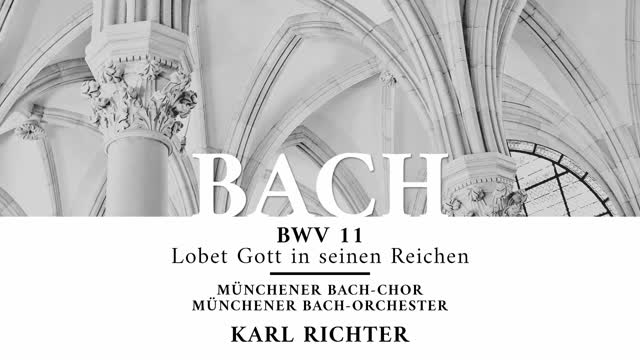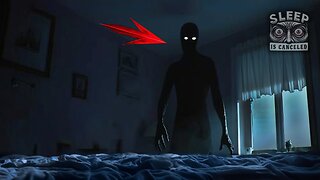Premium Only Content

Cantata BWV 11, Lobet Gott in seinen Reichen - Johann Sebastian Bach 'Karl Richter'
🎻 Enjoy the music. Please Like, Comment & Subscribe, this is immensely appreciated 🎻
Composition Year: 1735 in Leipzig
First performance: 1735-05-19 in Leipzig
Dedication: Ascension Day
Performers: Edith Mathis - Sopran • Anna Reynolds - Alto • Peter Schreier - Tenor • Dietrich Fischer-Dieskau - Basso. • Münchener Bach-Chor • Münchener Bach-Orchester • Karl Richter - Dirigent.
Recorded: Munchen, Herkulessaal, 5/1973; 1&2/1974; 1/1975
1. Chorus: Lobet Gott in seinen Reichen (D major)
2. Recitative (tenor): Der Herr Jesus hub seine Hände auf
3. Recitative (bass): Ach, Jesu, ist dein Abschied schon so nah?
4. Aria (alto): Ach, bleibe doch, mein liebstes Leben (A minor)
5. Recitative (tenor): Und ward aufgehoben zusehends
6. Chorale: Nun lieget alles unter dir (D major)
7. Recitative (tenor and bass): Und da sie ihm nachsahen gen Himmel fahren
8. Recitative (soprano): Ach ja! so komme bald zurück
9. Recitative (tenor): Sie aber beteten ihn an
10. Aria (soprano): Jesu, deine Gnadenblicke (G major)
11. Chorale: Wenn soll es doch geschehen (D major)
Work:
Lobet Gott in seinen Reichen (Laud to God in all his kingdoms), BWV 11, known as the Ascension Oratorio (Himmelfahrtsoratorium), is an oratorio by Johann Sebastian Bach, marked by him as Oratorium In Festo Ascensionis Xsti (Oratorio for the feast of the Ascension of Christ), probably composed in 1735 for the service for Ascension and first performed on 19 May 1735.
Bach had composed his Christmas Oratorio, based on the gospels of Luke and Matthew, in 1734. He had composed an Easter Oratorio already in 1725. The text for the Ascension Oratorio, a compilation of several biblical sources, free poetry and chorales, was presumably written by Picander who had worked on the libretto for the Christmas Oratorio. It follows the story of the Ascension as told in Luke, Mark and the Acts of the Apostles. The oratorio is structured in eleven movements in two parts, taking about half an hour to perform. It is framed by extended choral movements, Part I is concluded by the fourth stanza of Johann Rist's hymn "Du Lebensfürst, Herr Jesu Christ" in a four-part setting. The closing chorale on the seventh stanza of Gottfried Wilhelm Sacer's "Gott fähret auf gen Himmel" is set as a chorale fantasia. The work is richly scored for the feast day, exactly like the Christmas Oratorio for four vocal parts, three trumpets, timpani, two flauti traversi, two oboes, strings and continuo. While the recitatives and the first chorale were new compositions, Bach based the other choral movements and the two arias on parts of earlier cantatas. He used the model for the alto aria again much later for the Agnus Dei of his Mass in B minor.
Extended info of this work: https://bit.ly/3JndPDG *Wikipedia
Wikipedia Extended biography: https://bit.ly/3yfbm90
***
If you have the means and desire to contribute to this channel, you can Buy Me a Tea - https://ko-fi.com/classicalmusicpd
***
ATTRIBUTION
Music contained in this video is licensed to, Archiv Produktion, Germany
-
 1:12:32
1:12:32
Classical Music P.D.
1 year agoSymphony No.5 - Gustav Mahler 'James Levine - 1977'
152 -
 LIVE
LIVE
Jeff Ahern
2 hours ago $0.92 earnedNever Woke Wednesday with Jeff Ahern( Leftists losing everywhere)
197 watching -
 9:04
9:04
GBGunsRumble
13 hours agoGBGuns Armory Ep 134 Walther PDP F Pro
46.2K1 -
 13:12
13:12
Melonie Mac
22 hours agoAspyr Teases Possible New Tomb Raider Games in Classic Remastered Style
39.7K7 -
 44:49
44:49
Chrissy Clark
16 hours agoThe Rise Of Female Shooters, ABC News’ $16M Settlement, & MORE I Underreported Stories
29K5 -
 2:49:13
2:49:13
InfiniteWaters(DivingDeep)
1 day agoIt's Over - The Matrix Is Cooked | Infinite Waters
23.9K9 -
 15:49
15:49
Chris From The 740
1 day ago $5.43 earnedThe EAA Girsan Influencer X - Not Your Grandpa's 1911
43.9K3 -
 25:38
25:38
Producer Michael
18 hours agoLuxury Souq's MULTI-MILLION DOLLAR Watch Collection!
95.8K5 -
 17:06
17:06
Sleep is CANCELED
23 hours ago10 SCARY Videos To Keep You Up All Night!
62.9K2 -
 2:37
2:37
Canadian Crooner
1 year agoPat Coolen | Let It Snow!
41.7K10